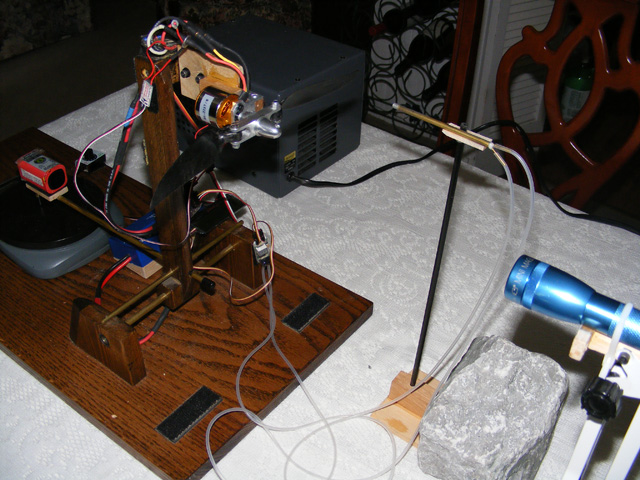Those of you who spend any time in this forum know that I test a lot of motors using a standardized test regime. In applying the "Scientific Method" and using the same equipment each time is, to my mind, the only way to get consistent and repeatable results.
I use my Dr Kiwi Mk II pusher stand, with an Ohaus CS2000 or CS5000 Digital scale, a Zurich DS-304M 0v-15v/25A power supply, a Medusa Analyzer Plus meter, a Hobbico Digital Mini-Tach, a Raytek IR temperature gun...and currently an Esky Servo Tester (rather than the FMA Rx and Futaba 6YG Tx I used to use). When current demands exceed the Zurich's ability to supply, I use a variety of Lipo packs... Gemini 2s 4000 and 3s 4000, Enerland 2s 5400 and 3s 6000, TP Prolite 3s2p 4200, and Evo 4s 2150 packs.
Now, through the generosity of Bill Parry at Eagle Tree, I have a v3 Logger with a Power Panel LCD, and temperature and rpm probes.
My usual test regime is to record the motor temperature, then run each motor/prop combination to WOT at incremental voltages as set on the PS - 7v, 8v, 9v, 10v, 11v - (sometimes 7.4v or 14.7v - the max. for the Zurich), for just long enough in each burst (estimated at 15-20 seconds) to record volts, amps, watts, thrust (g) and rpm. At the end of such a series, I'll record the motor temperature, usually directly from the exposed windings.
Yesterday I set up a new v3 Logger and so, for the first time, I actually have the time intervals for each "burst" recorded, plus, of course, the other parameters such as volts, amps, rpm. As I suspected, for each burst to WOT, I can manage to record all these parameters within about 10-12 seconds, so that means that an entire series at five different voltages has the motor running for only 60 seconds total. If it gets too hot within that time, then I reckon the motor is not going to cope too well in real life [in-flight cooling, unloading and all that stuff not withstanding]. I usually mount test motors using aluminum stick mounts, so, with the temperature probe attached to a mounting screw, I can get an idea of case temperature during and after the run.
So far the "airspeed probe" has not been a huge success - obviously it is designed for measuring inflight speed (which I'm sure it does admirably), but expecting it to accurately measure "velocity off the prop" is perhaps asking a bit much.
